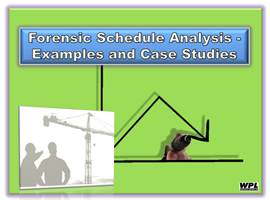Forensic Schedule Analysis -
Examples and Case Studies
Presented by:
Mark Nagata, PSP, Shareholder and Director
Trauner Consulting Services, Inc.
Time is money and there are real costs to every member of the project team associated with delay. For contractors and subcontractors, delays mean higher overheads, higher labor costs, higher equipment costs, and higher material costs. For public agencies, private developers, and other owners, delays mean higher administrative costs and real impacts to the economic viability of the project. In order to be reimbursed for these costs, you have to show that the other party to the contract delayed you.
The objective of this program is to teach you how to perform the analysis of project delays required to establish the cause and duration of the critical delays you experienced. The title says you’ll learn how to do "forensic" delay analysis. That just means that we’ll be focusing on delays that have already occurred on your project and are unlikely to be recovered through acceleration. We’ll use the Recommended Practice for Forensic Schedule Analysis published by AACEI as the foundation for our presentation. But the program itself will be loaded with practical examples and real case studies to show simple and successful approaches to the quantification of delays.
This informative 90-minute program will:
- Set the stage by briefly introducing basic CPM scheduling terminology such as “float,” the longest path, and the critical path.
- Introduce the AACEI document, “Recommended Practice for Forensic Schedule Analysis.” Though not quite an industry standard (there really isn’t such a thing in the world of schedule analysis), it’s a widely used treatise that identifies and describes the many approaches to the analysis of delays. We’ll show you what’s important to know in this 100+ page document and how to use the information it contains to establish your entitlement to a time extension and reimbursement of your delay costs.
- Help you work through several examples and case studies showing you how to apply a few basic principles and approaches to the identification and quantification of critical project delays.
- And much, much more!
Who Will Benefit?
This presentation is a must if you’re a contractor, public or private owner, subcontractor, construction manager, owner’s representative, architect, or other design professional providing project oversight services. The program will also be invaluable to the attorneys who represent these parties in disputes.
Meet Your Presenter:
 Mark Nagata, PSP, Shareholder and Director
Mark Nagata, PSP, Shareholder and Director
Trauner Consulting Services, Inc.
Mark Nagata’s expertise lies in the areas of construction claims preparation and evaluation, development and review of critical path method schedules, delay analysis, dispute resolution, specification writing, and training. Mark was a contributing author and he continues to provide additional revisions to the Association for the Advancement of Cost Engineering International’s Recommended Practice No. 29R-03 for Forensic Schedule Analysis. This is the first industry publication to comprehensively classify the many schedule analysis techniques. Mark’s contribution included describing and defining the Contemporaneous Period Analysis, also called the Contemporaneous Schedule Analysis.
Mark is a co-author of Construction Delays: Understanding Them Clearly, Analyzing Them Correctly. He also continually writes technical papers and articles for industry publications and speaks nationally on scheduling and claims analysis topics. Complete bio...


 Mark Nagata, PSP, Shareholder and Director
Mark Nagata, PSP, Shareholder and Director